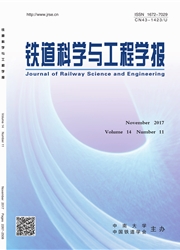

 中文摘要:
中文摘要:
土工加筋结构在工程实际中被广泛采用,采用基于极限分析理论上限法对其稳定性能的分析比较常见。但目前基于极限分析法的加筋边坡稳定性常常采用的评定指标(临界高度Hcr、稳定性系数Nx或临界加筋强度k0)与其他常用方法(极限平衡法、数值分析法)采用的安全系数(Fs)评定指标不完全统一,故该分析方式往往无法在实际工程中直接应用。在已有研究的基础上,将强度折减技术与极限分析上限定理结合,采用极限分析上限方法利用安全系数(Fs)评定指标对加筋边坡进行稳定性上限分析,并与已有研究成果进行对比分析。数值计算与分析结果表明:基于强度折减的极限上限加筋边坡稳定分析方法能够获得与现有常用方法一致的边坡稳定性评定指标(安全系数Fs);本文方法与其他不同方法获得的安全系数Fs误差颇小,可以说明本文方法的有效性,研究结果对工程应用有实际意义。
 英文摘要:
英文摘要:
The reinforced soil structures are employed widely due to the technical and economical advantages in static state. The selected evaluation index (critical height Her, critical reinforcement strength k0 or stability coef- ficient N~ ) based on the limit analysis theorem for reinforcement slope stability, which is different from the evalu- ation index (safety factor Fs ) based on other common methods such as the limit equilibrium method and the nu- merical analysis method, is inconvenient for application during the engineering practice. Based on the upper bound limit analysis theorem and the shear strength reduction technique, the equation for expressing the critical limit - equilibrium state was employed to define the safety factor and its corresponding critical failure mechanism for a given reinforcement embankment slope by means of the kinematical approach of limit analysis theot% The traditional definition of factor of safety was adopted in the present method so that the results from the limit analy- sis can be directly applied in engineering practice. The case study and comparative analysis show that the solu- tions presented agree well with available predictions, and the effectiveness and validity of the analysis method can be illuminated.
 同期刊论文项目
同期刊论文项目
 同项目期刊论文
同项目期刊论文
 Upper bound analysis for the ultimate pullout capacity of vertically loaded strip plate anchors cons
Upper bound analysis for the ultimate pullout capacity of vertically loaded strip plate anchors cons Finite Element Upper Bound Stability Analysis for Railway Embankment Slope under Rainfall Infiltrati
Finite Element Upper Bound Stability Analysis for Railway Embankment Slope under Rainfall Infiltrati Complex Multi-Segment Sliding Surface Search Method on Stability Analysis of Two-Dimensional Irregul
Complex Multi-Segment Sliding Surface Search Method on Stability Analysis of Two-Dimensional Irregul 期刊信息
期刊信息
